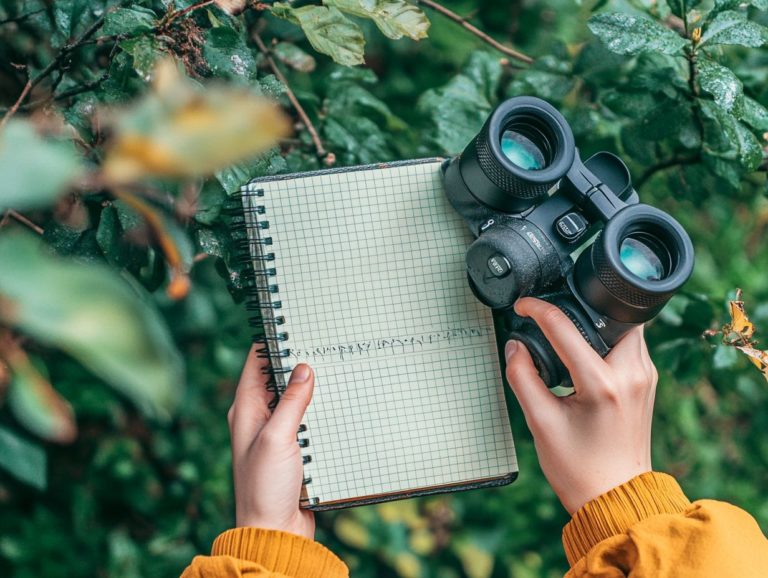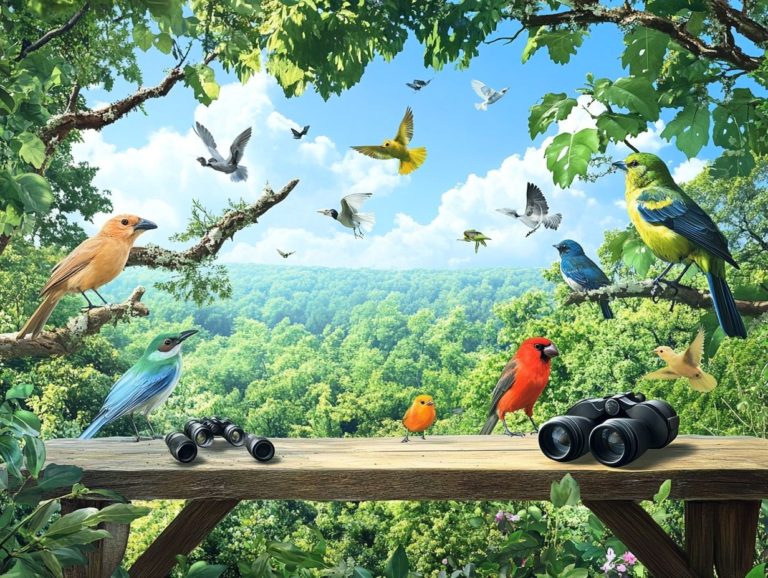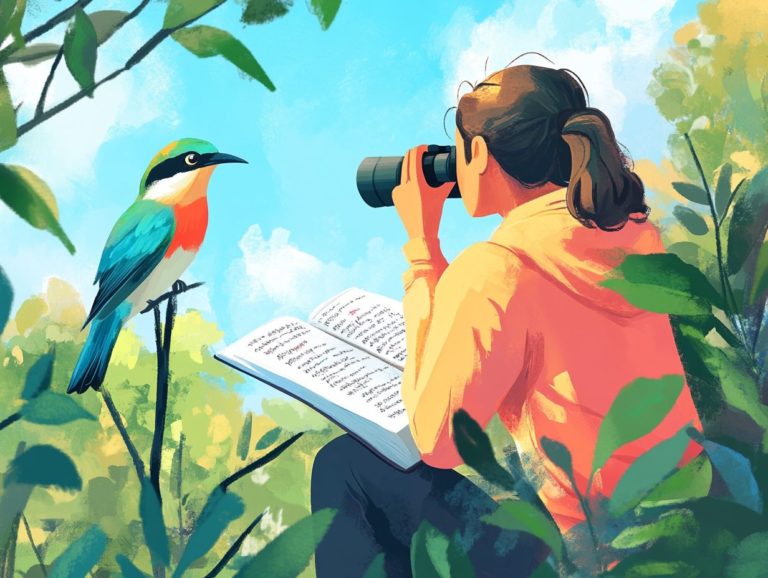How Can I Contribute to Citizen Science as a Bird Watcher?
Bird watching is not just an enjoyable pastime; it’s a thrilling way to contribute to scientific research! This article will define Citizen Science, discuss how individuals can engage in it, examine the tools required for participation, and explore the impact of citizen science observations. It aims to provide a comprehensive understanding of how to blend the joy of bird watching with meaningful contributions to scientific research.
Contents
- Key Takeaways:
- The Role of Citizen Science in Bird Watching
- How to Get Involved in Citizen Science as a Bird Watcher
- Tools and Techniques for Collecting Data
- Contributing to Scientific Research and Conservation Efforts
- Tips for Successful Citizen Science Bird Watching
- Frequently Asked Questions
- How can I start contributing to citizen science as a bird watcher?
- What types of data can I collect as a bird watcher for citizen science?
- Can I contribute to citizen science as a bird watcher if I am a beginner?
- How can I ensure the accuracy of my data as a bird watcher in citizen science?
- Are there any ethical considerations I should keep in mind as a bird watcher contributing to citizen science?
- How can I better support citizen science as a bird watcher?
Key Takeaways:
- Citizen science allows bird watchers to contribute to important scientific research and conservation efforts.
- Joining existing projects or creating your own are both great ways to get involved in Citizen Science as a bird watcher.
- Using proper tools and techniques and following best practices for data collection are key to successful Citizen Science bird watching.
The Role of Citizen Science in Bird Watching
Citizen Science plays a vital role in bird watching and, more broadly, in environmental research. It encourages individuals and communities to actively participate in these fields. This involvement fosters conservation efforts and enhances our understanding of wildlife.
Projects like eBird and the Great Backyard Bird Count provide valuable insights. They help us understand avian population dynamics, migration patterns, and breeding habits. These initiatives have a global impact on conservation strategies and provide a unified approach to studying birds and their habitats.
Citizen Science promotes a deeper appreciation for the variety of life and creates opportunities for individuals and communities to engage in environmental stewardship. As a result, this leads to a network of informed citizens dedicated to preserving and improving the health of the natural ecosystems they inhabit.
Understanding Citizen Science: Its Importance and Benefits
Citizen Science is a collaborative approach to scientific research. It engages the public in collecting and analyzing data, which is essential for understanding and conserving the variety of life. This innovative method not only enables individuals to contribute to scientific endeavors but also fosters a sense of community and environmental responsibility.
By involving volunteers in the research process, essential data sets can be expanded and enriched. This enables the tracking of changes in ecosystems over time. Community participation is particularly vital in environmental studies, as local knowledge significantly enhances data collection efforts.
For example, initiatives like the Great Backyard Bird Count encourage individuals to count bird species in their backyards. These efforts yield invaluable insights into bird populations. Similarly, the eBird project allows bird watchers to log their sightings. This creates a comprehensive database that aids in monitoring migration patterns and habitat health.
Through such projects, contributions from citizens not only enhance scientific understanding but also play a crucial role in conservation strategies.
How to Get Involved in Citizen Science as a Bird Watcher
Citizen Science, particularly in the realm of bird watching, offers countless opportunities for individuals to participate in environmental research and conservation efforts. It also deepens their appreciation of avian diversity.
Joining Existing Projects
Participating in established Citizen Science programs such as eBird, Project FeederWatch, and the Great Backyard Bird Count allows birders to engage in meaningful scientific research. It also enhances their own bird watching skills.
These platforms serve as excellent entry points for individuals who wish to connect with their local ecosystems. They can contribute to vital conservation efforts. Participants can easily find these projects and more through their respective websites. There, they can create accounts and follow the provided registration steps.
The data collected ranges from bird sightings and feeding habits to migration patterns and population numbers. Each of these plays a crucial role in informing conservation strategies and raising awareness about bird ecology.
Engaging in these programs fosters a community of shared experiences, tips, and enthusiasm. All of this enriches our appreciation of nature and the importance of its protection.
Don’t wait! Join a Citizen Science project today and be part of something bigger!
Creating Your Own Project
Starting your own Citizen Science project offers many benefits. You can contribute valuable data for biodiversity monitoring and engage your community in bird conservation.
Careful planning and well-defined goals are crucial. They help you set up effective data collection methods.
Recruit local volunteers and provide training to guarantee consistent and accurate data collection.
Using established scientific protocols boosts the credibility of your findings, allowing them to be compared with existing studies. Grassroots initiatives empower community members to positively impact local ecosystems.
Tools and Techniques for Collecting Data
Accurate data collection is vital for Citizen Science projects. Choosing the right tools enhances the reliability and precision of your bird observations.
Binoculars and Other Equipment
Binoculars are essential for bird watchers. They help you study distant species and gather important data.
Various types of binoculars cater to different needs. Some offer wider fields of view, while others provide improved optical clarity.
Roof prism binoculars are compact and great for field trips. In contrast, Porro prism binoculars offer better depth perception.
Other useful equipment includes:
- field guides to local species
- notepads for taking notes
- spotting scopes
This combination of tools allows bird watchers to capture high-quality images and share valuable observations with scientists and conservationists.
Recording Observations
Accurate recording of observations is crucial for contributing to Citizen Science. This ensures your data is reliable and valuable for conservation efforts.
Bird watchers have various methods to document their findings. Many prefer field notebooks to record details about each sighting, including behavior and habitat.
Mobile apps are gaining popularity due to their convenience. They allow users to record sightings on-the-go with GPS-enabled location tracking.
Devices for capturing bird sounds also offer vital information on vocalizations. Whatever method you choose, ensure accurate recording, as data on bird population trends helps researchers and conservationists.
Contributing to Scientific Research and Conservation Efforts
Join the movement! Citizen science is key to understanding wildlife dynamics and boosting biodiversity through scientific research and conservation initiatives.
How Your Data is Used
The data collected by volunteers who help collect data about nature is extremely valuable for researchers in developing models that illustrate long-term trends in bird populations and migration patterns. This information enables researchers to draw conclusions about the health of various species and their environments.
The benefits of citizen science data for researchers include the following:
- Enhanced Data Quality: By participating in citizen science projects, the general public provides researchers with a wealth of observational data that would be difficult for scientists to gather independently. This significantly increases the availability of high-quality data for scientific studies.
- Data Validation: The collaborative nature of citizen science projects allows researchers to validate the data collected. With multiple citizen scientists often reporting on the same topic, researchers can statistically assess trends, anomalies, and patterns.
- Time and Cost Efficiency: Citizen science reduces the time and costs associated with data collection, which typically requires trained scientists. The contributions of citizen scientists enable researchers to allocate their time and funding more effectively toward data analysis and model generation.
- Model Generation: The data gathered through citizen science allows scientists to create robust models that reveal trends over time. These models are crucial for analyzing a variety of questions about species and their environments.
The accompanying image presents the results of a citizen science survey on the nesting success of Atlantic puffins (Fratercula arctica) in the UK. The blue line illustrates the number of successful nests per year, while the bold red line indicates that the average number of successful nests from 2006 to 2018 was 81.
Notably, adverse weather conditions in 2019 led to the lowest number of successful nests recorded during that period.
Impact on Bird Conservation
Citizen science plays a significant role in bird conservation by enhancing our understanding of population dynamics. This understanding can lead to targeted conservation efforts.
Through initiatives like the Great Backyard Bird Count, where participants record the presence of birds in their local areas, citizens have generated valuable data that enables researchers to monitor population trends.
This citizen-generated data raises awareness and directly informs critical conservation decisions. Such decisions include the establishment of protected areas for threatened habitats.
Volunteers tracking migratory patterns have demonstrated that the timing of spring migrations has shifted due to climate change. This shift has prompted a swift response from policymakers.
Getting involved is essential for keeping conservation efforts strong. Sustained engagement in citizen science enables individuals and communities to take proactive steps in stewarding biodiversity.
Tips for Successful Citizen Science Bird Watching
Citizen science bird watching is a form of environmental research that involves non-specialist volunteers gathering and sharing information about the natural world. Engaging in bird watching can be a rewarding experience, especially when it incorporates a range of effective practices in preparation, accuracy, and community involvement.
Best Practices for Data Collection
In Citizen Science bird-watching projects, best practices for data collection include note-taking, using a fixed format for notes, and providing adequate training to participants.
A toolkit of resources can greatly enhance these initiatives.
Participants should focus on recording the time, location, weather conditions, and specific behaviors of the birds they observe. The time of day is often crucial for interpreting the data, as many species exhibit distinct diurnal patterns.
Engaging with community outreach efforts can also improve the quality of observations.
Helpful tools such as notebooks or note-taking apps can facilitate data collection. Establishing a standard format for notes ensures a consistent process and enhances the comparability of data collected by different participants.
Employing audio recording devices can help capture detailed observations in the field.
Participants should collect all relevant data in an organized way. Regular training sessions can reinforce the importance of data accuracy, helping participants feel competent in their observations and assessments.
Utilizing digital tools or apps designed for tracking and submitting observations can further enhance the accuracy of data submission, making it a vital component of any scientific project.
Staying Safe and Ethical
Your safety is a top priority! Always follow ethical guidelines to protect both yourself and the wildlife. By respecting the natural habitats of the birds you study, enthusiasts can contribute to conservation efforts while enhancing their own experience.
This commitment enhances community involvement and fosters a responsible approach to wildlife observation.
This entails maintaining a safe distance from nesting and feeding birds, as disturbances can cause significant stress and even lead to abandonment. When navigating urban areas, remain aware of your surroundings and the birds, minimizing noise and movement to avoid startling wildlife.
Careful bird watchers are more likely to enhance the quality of their contributions, fostering a community of responsible individuals who value ethical bird-watching practices in citizen science.
Join organized events like Project FeederWatch or the Christmas Bird Count to actively contribute to ongoing research and conservation efforts!
Frequently Asked Questions
How can I start contributing to citizen science as a bird watcher?
There are several exciting ways you can make a difference! Join bird counts and surveys organized by citizen science programs like eBird or the Great Backyard Bird Count. You can also report bird sightings to online databases or apps designed for collecting bird data.
What types of data can I collect as a bird watcher for citizen science?
As a bird watcher, you can collect data on bird species, population numbers, behavior, and migration patterns. Take note of any changes in their habitat or environmental factors that may affect their populations, contributing to important conservation research.
Can I contribute to citizen science as a bird watcher if I am a beginner?
Yes, absolutely! Even if you are new to bird watching, you can still contribute valuable data to citizen science projects. Many programs, including those organized by the Cornell Lab of Ornithology, provide resources and training materials to help beginners identify and record bird species effectively.
How can I ensure the accuracy of my data as a bird watcher in citizen science?
To ensure the accuracy of your data, follow the guidelines provided by the citizen science program you are participating in. This may include using specific observation techniques, recording data in a standardized format, and double-checking your information before submitting it. Familiarizing yourself with the monitoring protocols of each program can also enhance the reliability of your contributions.
Are there any ethical considerations I should keep in mind as a bird watcher contributing to citizen science?
Yes, always prioritize the well-being of birds and their habitats. Practice responsible bird watching by not disturbing nesting birds, respecting private property, and avoiding overcrowding wildlife.
Your efforts support local and global conservation efforts—make a positive impact!
How can I better support citizen science as a bird watcher?
You can also support citizen science by promoting awareness and appreciation for birds. Volunteer for organizations like the Audubon Society or participate in workshops related to bird research.
These activities foster community engagement and make a difference for local biodiversity. Join the movement for bird conservation today!






